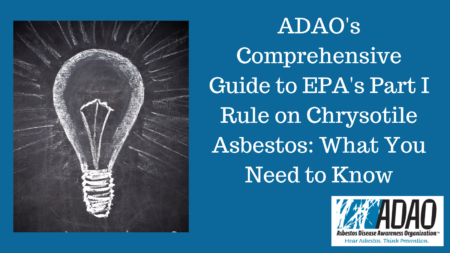Posted on April 24, 2024
What is simple, isn’t always easy.
 On March 28, 2024, the U.S. Environmental Protection Agency (EPA) took a significant step forward in protecting public health by issuing a final rule under the Toxic Substances Control Act (TSCA). This rule targets the risks posed by chrysotile asbestos, the only form of asbestos currently imported, processed or distributed in the United States. Recognized as a critical milestone, this regulation was the result of nearly eight years of collaborative efforts involving various stakeholders, including the Asbestos Disease Awareness Organization (ADAO). It specifically addresses the “unreasonable risk of injury to health” identified in certain conditions of use (COUs) of chrysotile asbestos, which is known to cause severe diseases, including ovarian and laryngeal cancers, mesothelioma and cancers of the lung, primarily due to chronic inhalation.,
On March 28, 2024, the U.S. Environmental Protection Agency (EPA) took a significant step forward in protecting public health by issuing a final rule under the Toxic Substances Control Act (TSCA). This rule targets the risks posed by chrysotile asbestos, the only form of asbestos currently imported, processed or distributed in the United States. Recognized as a critical milestone, this regulation was the result of nearly eight years of collaborative efforts involving various stakeholders, including the Asbestos Disease Awareness Organization (ADAO). It specifically addresses the “unreasonable risk of injury to health” identified in certain conditions of use (COUs) of chrysotile asbestos, which is known to cause severe diseases, including ovarian and laryngeal cancers, mesothelioma and cancers of the lung, primarily due to chronic inhalation.,
While the EPA’s asbestos rule is a landmark step forward, it does not ban all imports and uses of the deadly chemical. The new rule ends the importation and use of only chrysotile asbestos, just one of six asbestos fibers, for only six conditions of use. However, the EPA rule does not restrict the importation and use of five other recognized asbestos fibers, all of which are carcinogenic. There are also 31 other conditions of use not addressed in the rule.
The EPA’s rule imposes strict prohibitions on the manufacture, importation, processing, distribution, and commercial use of chrysotile asbestos in these six industrial applications:
- Chrysotile asbestos diaphragms in the chlor-alkali industry—traditionally used in the production of chlorine and sodium hydroxide.
- Chrysotile asbestos-containing sheet gaskets in chemical production—typically used to seal pipes and pieces of machinery.
- Chrysotile asbestos-containing brake blocks in the oil industry.
- Aftermarket automotive chrysotile asbestos-containing brakes/linings.
- Other chrysotile asbestos-containing vehicle friction products.
- Other chrysotile asbestos-containing gaskets.
These regulations impose deadlines on companies to adhere to the new policies, precise direction on disposal, and recordkeeping requirements to ensure compliance with the new standards. For example, in the chlor-alkali industry—one of the primary sectors affected—the rule mandates an immediate ban on manufacturing (including importation) of chrysotile asbestos for diaphragms starting May 28, 2024. However, several other restrictions laid out in the regulation will not take effect for over five to twelve years, which will allow certain facilities to continue using chrysotile asbestos for years to come. Asbestos users will be under strict compliance and certification requirements during these phase-out periods.
The rule details exemptions and additional timeframes for specific uses of chrysotile asbestos in industries like titanium dioxide production and nuclear material processing. These exemptions aim to balance health risks against technical and operational capacities.
Significantly, the EPA’s regulatory action incorporates robust workplace safety measures, including interim controls and exposure monitoring to protect workers from chrysotile asbestos exposure until full compliance is achieved. These interim measures align with existing Occupational Safety and Health Administration (OSHA) standards, underscoring the agency’s commitment to immediate risk mitigation.
Moreover, the rule’s disposal requirements align with current EPA and OSHA regulations, ensuring that chrysotile asbestos-containing materials are disposed of safely and responsibly to minimize health risks associated with improper disposal.
There is much more to be done, as this is not an outright ban. For more detailed information, ADAO has tried to answer common questions in our post, “ADAO EPA Part 1 FAQs,” which also provides additional insights about the rule’s impact. Furthermore, our recent press release offers an in-depth analysis of the rule and ADAO’s role in advocating for these crucial regulatory changes.
In just 60 days, the EPA has announced two rules (Asbestos Reporting and Part 1) and released the very important draft Risk Evaluation for Asbestos Part 2. In our efforts to prevent exposure to eliminate all asbestos-caused diseases, we invite you to join us for our upcoming webinar: Legacy Asbestos: Understanding Risks, Prevention, and New Regulations taking place on Tuesday, April 30, at 1:00 PM ET. The webinar will provide essential resources for preventing asbestos exposure and fostering safer environments in homes, schools, and workplaces. Register for this free Zoom webinar here.
Knowledge is Powerful.
Linda Reinstein
